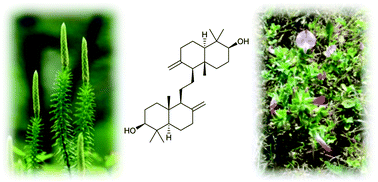Plant triterpenoids with bond-missing skeletons: biogenesis, distribution and bioactivity†
Abstract
Covering: up to December 2018
The polycyclic ABCD(E) framework of triterpenoids can miss a single endocyclic C–C bond as a result of a modification of the cyclization cascade that triggers their formation (interrupted- or diverted cascades), or can be the result of post-cyclization ring cleavage by late-stage oxidative modifications (seco-triterpenoids). Because of mechanistic and biogenetic differences, ring opening associated with loss of a skeletal fragment, as in nor-seco-triterpenoids (limonoids, quassinoids), will not be covered, nor will compounds where ring opening is part of a fragmentation cascade or of a multiple diversion from it. Even with these limitations, 342 bond-missing triterpenoids could be retrieved from the literature, with transversal distribution in the plant kingdom. Their structural diversity translates into a variety of biological targets, with dominance of potential applications in the realm of cancer, neuroprotection, and anti-infective therapy. In addition to the bioactivity and chemotaxonomic relevance of bond-missing triterpenoids, current knowledge on the genetic basis of interrupted- and diverted oxidosqualene cyclases will be summarized. This untapped source of enzymes could be useful to selectively modify triterpenoids by metabolic engineering, circumventing the bottlenecks of their isolation (poor yield or inadequate supply chain) to explore new areas of their chemical space.



 Please wait while we load your content...
Please wait while we load your content...